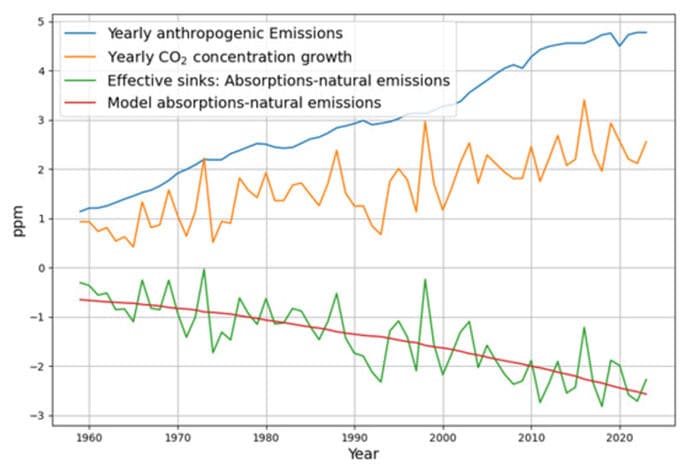From: Climate Etc.
By: Dr. Joachim Dengler
Date: August 25, 2024
Extension of the linear carbon sink model – temperature matters
This post is the second of two extracts from the paper Improvements and Extension of the Linear Carbon Sink Model.
Introduction – The linear carbon sink model has a limitation
The relation between CO2 Emission and resulting concentration of the last 65 years can be best understood with a simple top-down model, where the net sink effect, which is the difference between anthropogenic emissions and atmospheric CO2 concentration growth, is modelled with a linear function of atmospheric CO2 concentration as shown in Figure 1. It is important to note, that the net sink effect represents in fact the sum of all absorptions – oceanic, land plants, and phytoplankton — reduced by the natural emissions.

Figure 1. The measured yearly sampled time series of anthropogenic emissions and yearly CO2 concentration growth. Both effects are measured in or have been converted to ppm in order to guarantee comparability. Their difference is the growing carbon sink effect, modelled linearly by 0.018*C – 5.2 ppm, where C represents the CO2 concentration time series.
The interpretation of the model is that the proportionality factor of the linear relation is a sum of the unknown proportionality factors of all contributing absorption processes, such as photosynthesis of land plants, photosynthesis of phytoplankton, and the physical ocean absorption. It has been shown, that all these processes are approximately linear functions of atmospheric CO2 concentration, justifying that their proportionality factors can be added up. The constant of the linear model is interpreted as the natural emissions. Implicitly this assumes that natural emissions are considered to being approximately constant. (continue reading)
Extension of the linear carbon sink model – temperature matters

